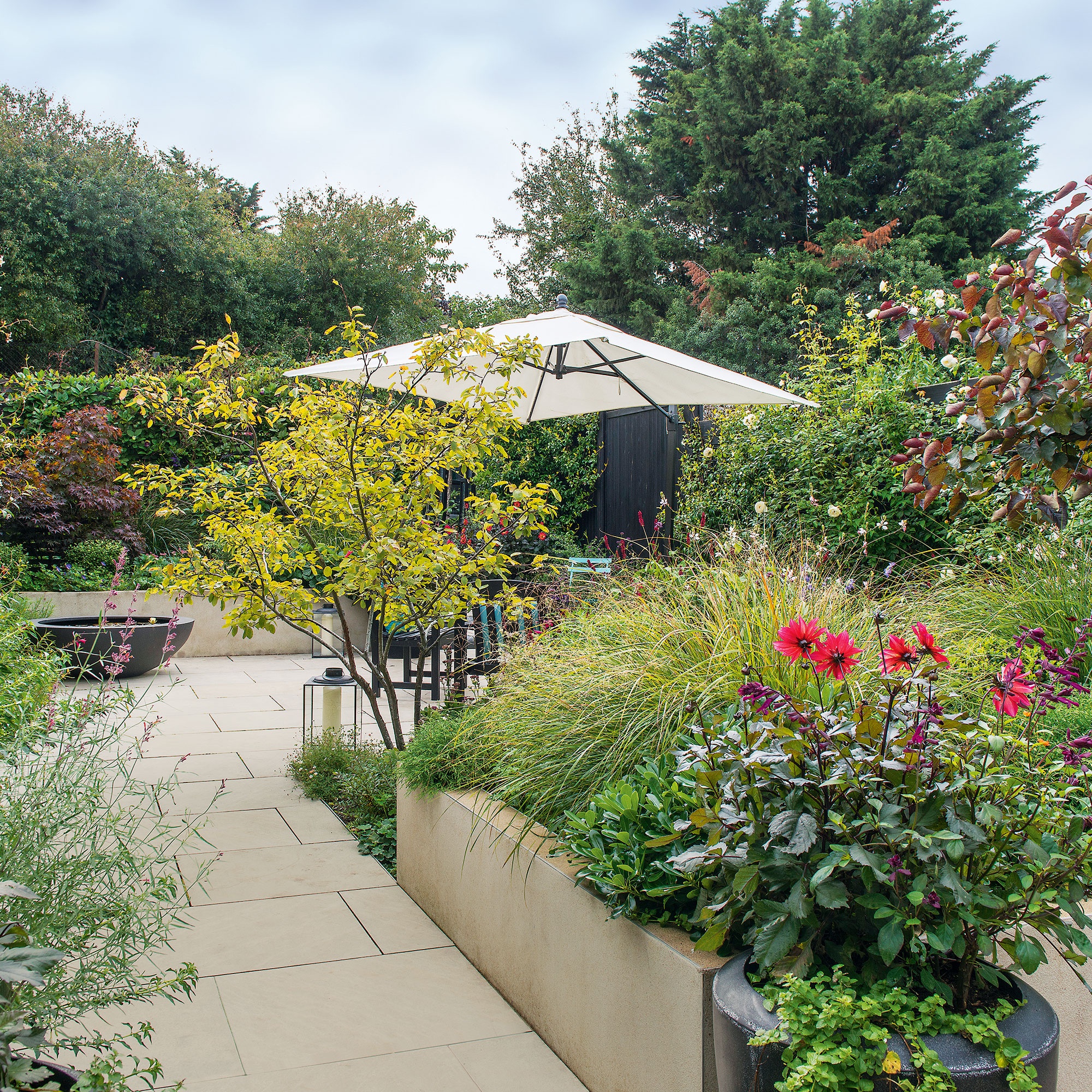
Defining your garden borders can organise and neaten the space, but you can't do it without the right garden edging ideas.
If you want to keep your garden ideas in check, garden edging is the way forward. You can use whichever materials fit your garden theme, from rustic wood to manicured paving blocks.
‘Garden edging is perfect for lining borders or defining front garden boundaries and driveways,' says Jenny Davis, marketing manager at Forest Garden. 'It can also be used to create retaining walls and raised beds, transforming borders in no time.'
There are practical benefits, too. ‘Edging also offers practical benefits as it creates a barrier between lawns and borders, preventing unwanted grass growing in flower beds,' says Jen Monaghan, marketing manager at Bradstone.
Garden edging ideas
Edging provides an extra finishing touch to your patios, flower beds and lawn ideas, making them look sleek and polished. It also makes a great budget garden idea if you're looking to revamp your garden without spending too much.
We've rounded up our favourite garden edging ideas to give you a little inspiration, with tips from garden design experts to help us along the way.
1. Lay clay brick edging
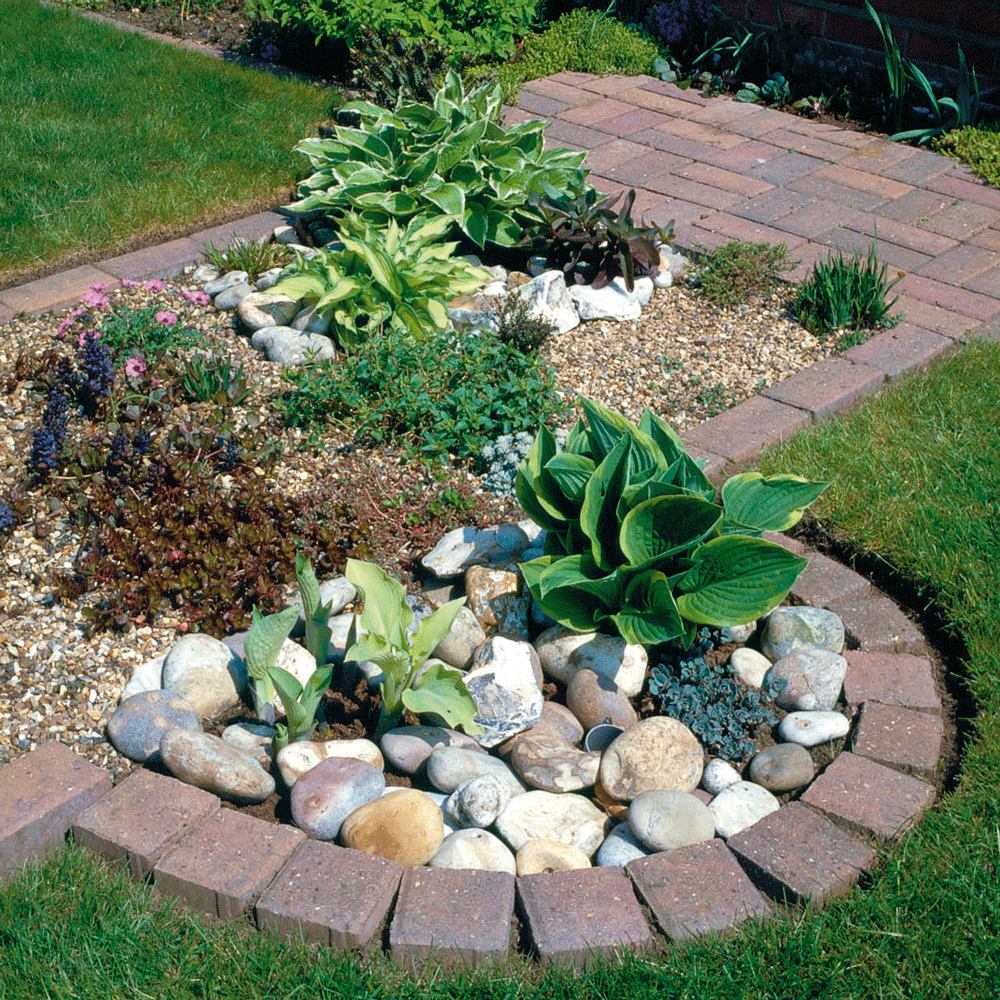
For a more permanent feature, patio edging is available in various options.
'If you want a formal and traditional look for your patio, then clay brick edging is the way to go,' says Georgina Read from Paving Superstore. 'Using clay bricks as edging is a classic and timeless option for patio edging that can add a warm and rustic element to your outdoor space.'
'You can choose from different colours and sizes of brick, and mix and match them to create a unique design that complements your patio.'
2. Use raised patio edging
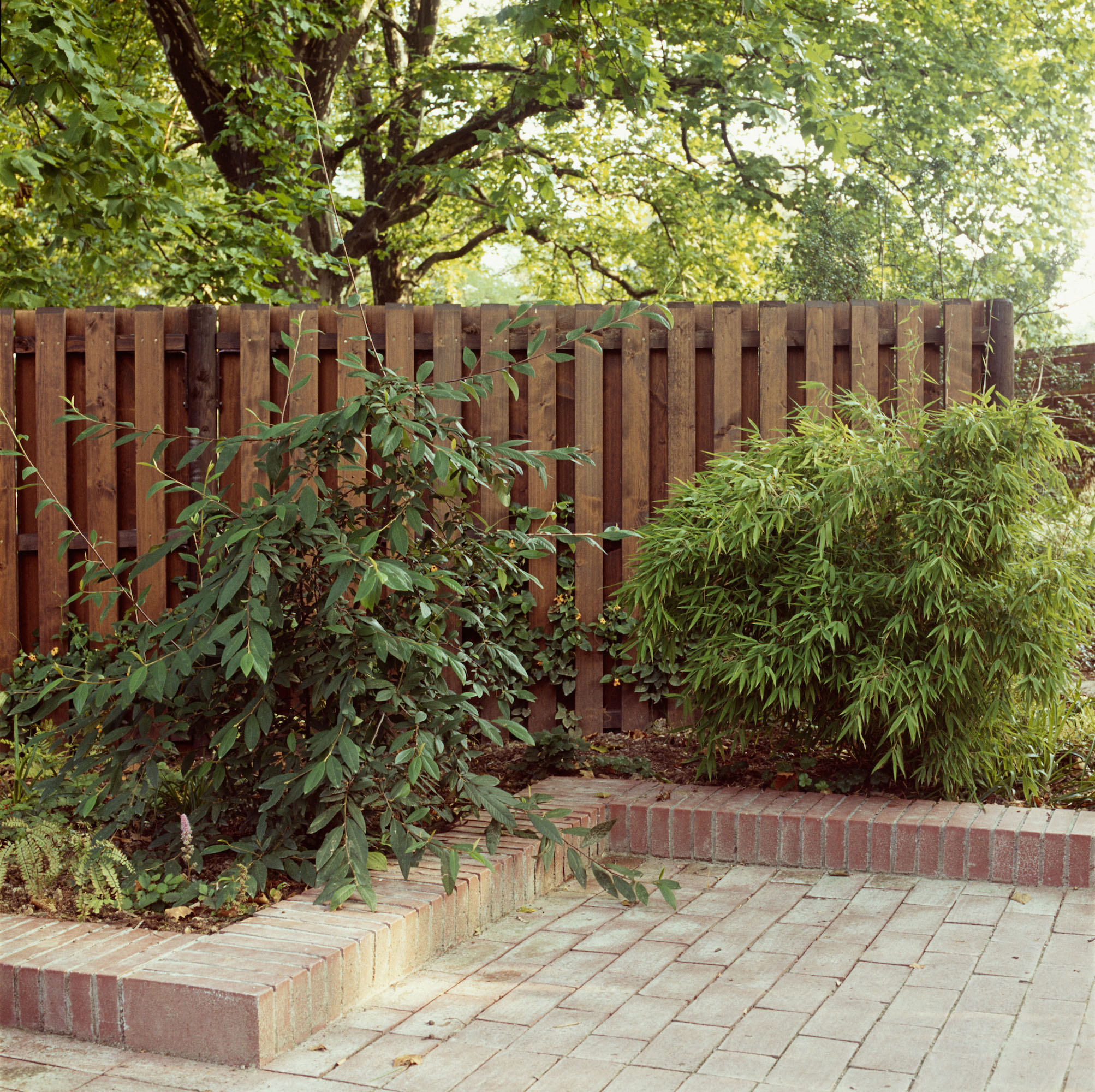
Take your edging to the next level by raising it around your garden borders. 'Raised patio edging is a creative and practical option that can add an interesting visual element to your outdoor space,' says Georgina.
'Raised path edging involves installing a raised strip of paving material around the perimeter of your patio, creating a distinct border that separates the patio from the surrounding landscaping.'
'Raised edging can add an extra design layer to your outdoor space, and also help contain planting areas and prevent soil or mulch from spilling onto your patio.'
3. Use logs
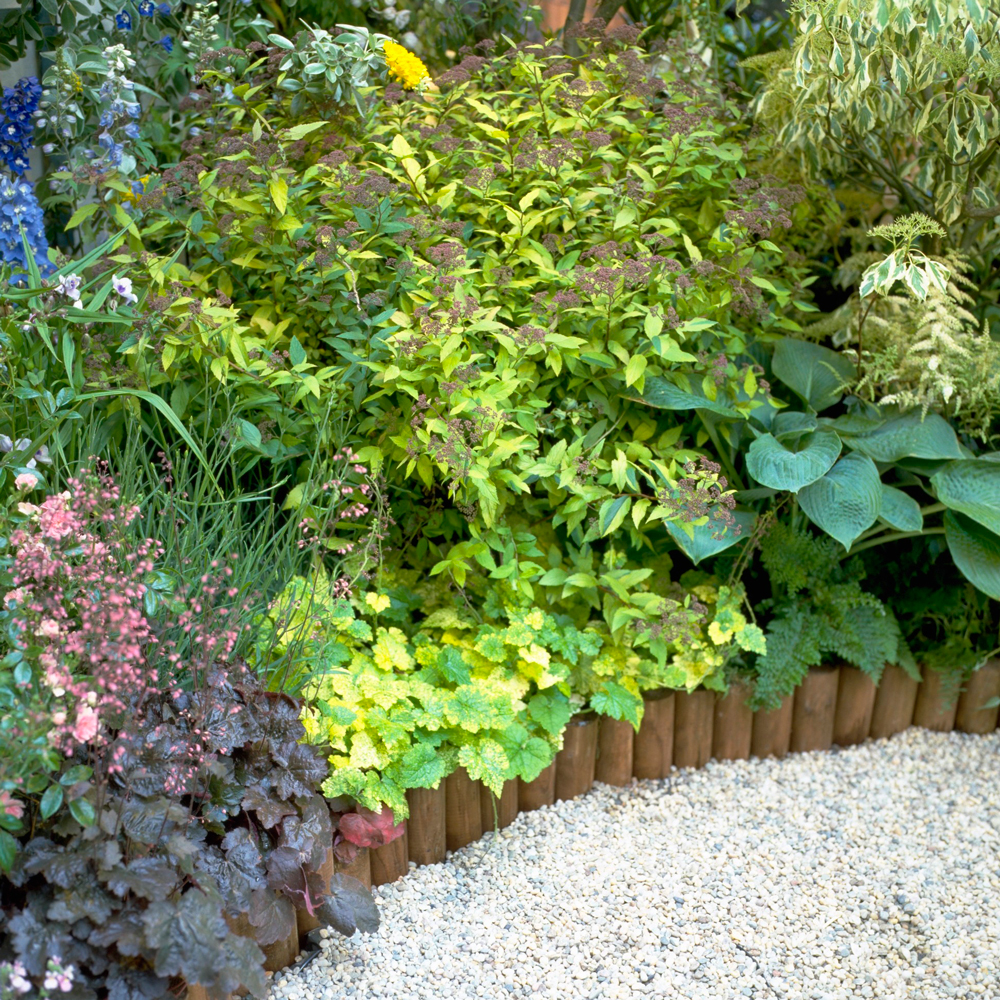
Use logs to edge your garden for a natural, rustic look. 'Choose logs that are similar in shape and size,' advises Lee Trethewey, garden design and interiors expert at Sustainable Furniture. 'I recommend hardwood logs as they are more sturdy. Peel off the bark to reduce the risk of pests and rot, and treat them with a weatherproof coat.'
'Dig a shallow trench where you want your edging to go, making sure it's the right depth to hold the logs. Stand the logs vertically in the trench, side by side, ensuring they're both level and secure.'
'Then, backfill the trench with soil,' concludes Lee. 'You need to make sure it's packed firmly around the base of the logs in order to hold them in place.'
You could also buy pre-formed log edging like the Timber Border Log Edging Roll from Wickes.
4. Invest in metal edging
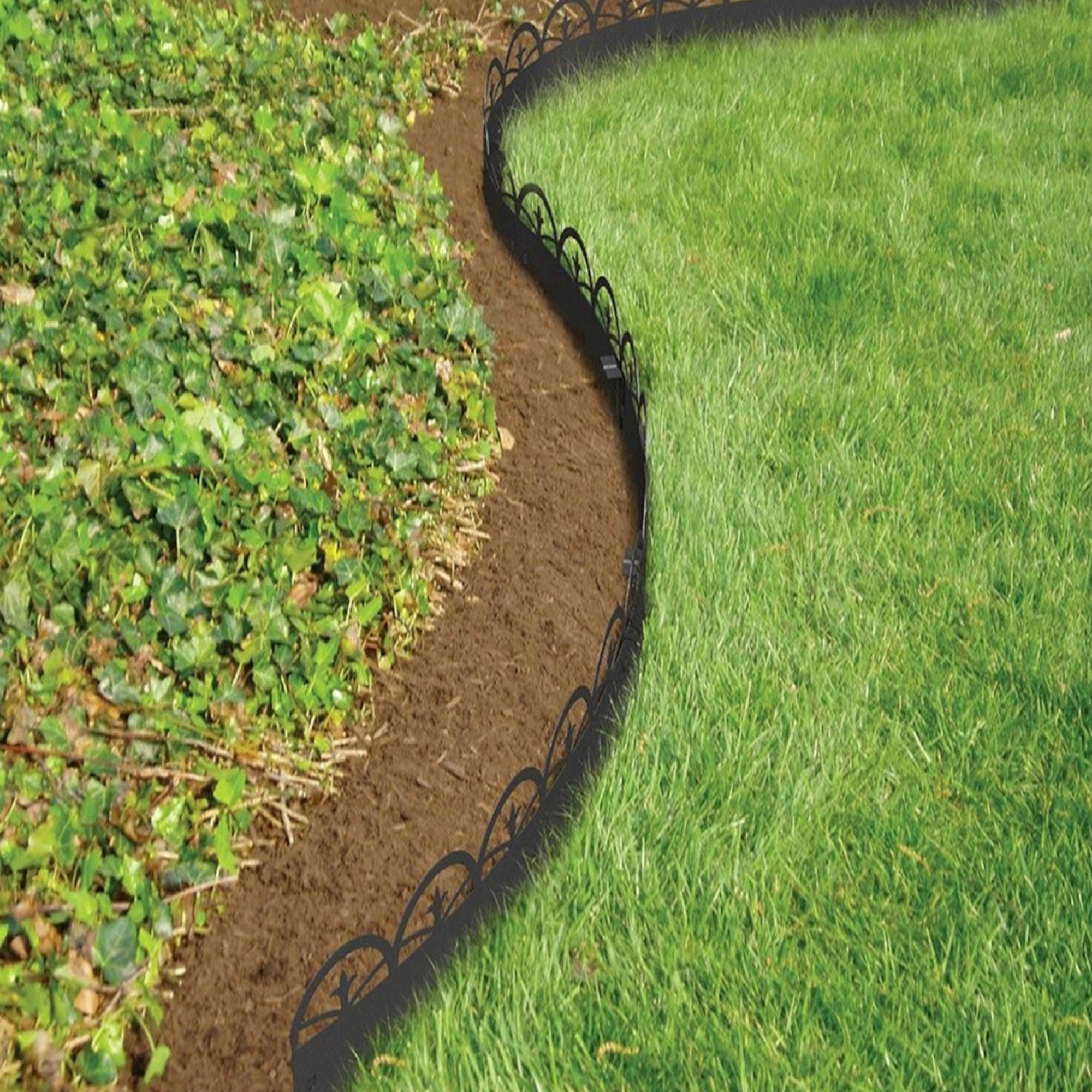
We would all love to have that beautiful manicured lawn look you see at flower and garden shows and metal edging can help you achieve that. If you have spent time on your landscaping ideas and want them to last, metal edging is durable and resistant to poor weather conditions. Metal edging provides a sharp and clear barrier and is easy to install, but with heavier metal, you will need to use thick gloves to protect your hands.
When thinking about which metal to use for your edging, Paul McFadyen, managing director at metals4U advises using steel. ‘Steel is one of the strongest choices, as it holds shape over a long period of time and has slow corrosion rates, so it can withstand strong weather conditions. '
'It is also heavier and thicker than many other traditionally used edging materials and provides a sturdy separator to demarcate different areas of the garden. Steel is also tolerant to freezing conditions without becoming brittle or warping.’
Metal offers lots of different styles and designs to choose from so you can match the rest of your colourful garden ideas.
5. Use rubber edging
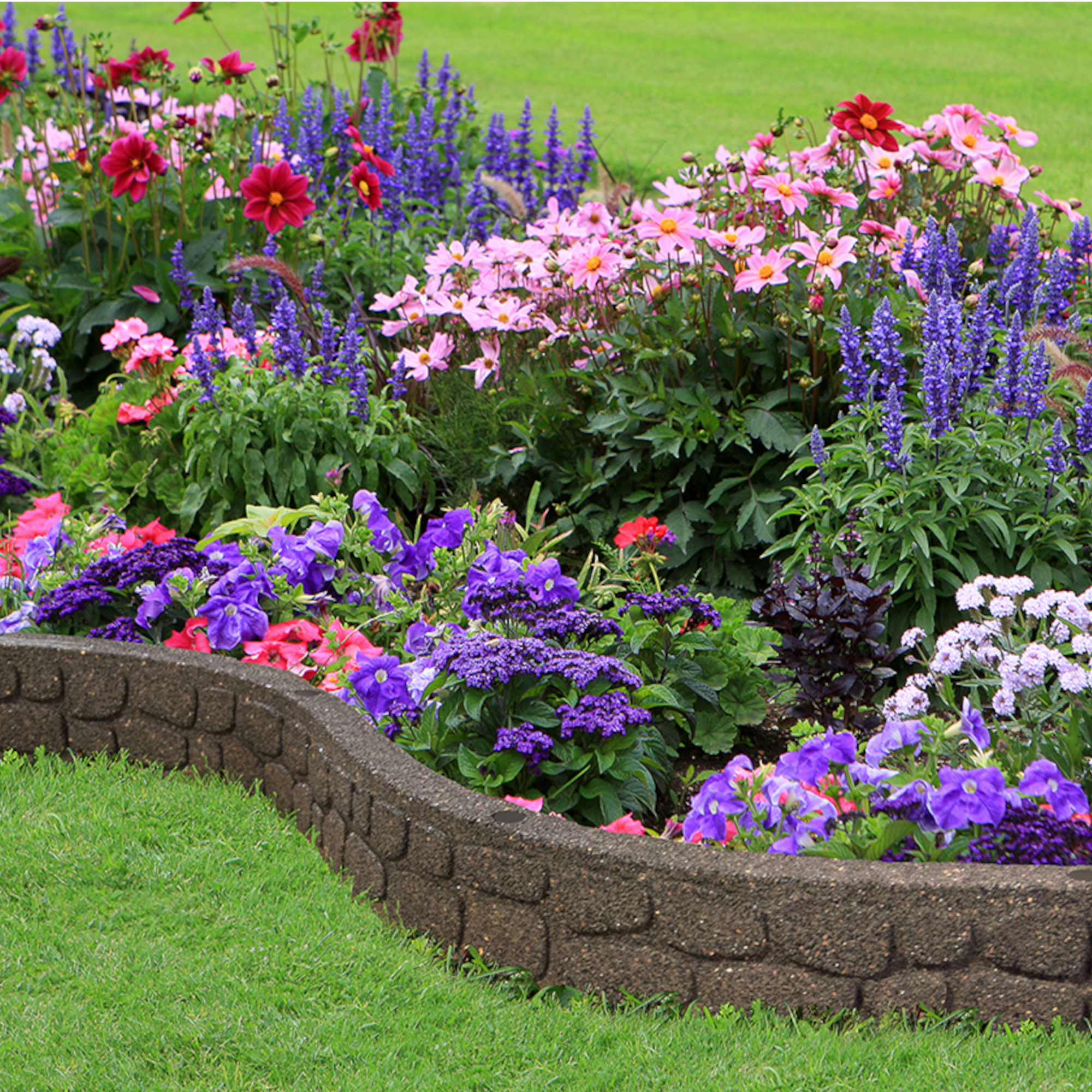
Rubber edging is a flexible and malleable material for edging and can be shaped to suit your specific edging needs. It's so versatile – it can come in brick shapes that can be stacked, strips which can be laid at different angles, and varying colours of bark. Not only does rubber edging look good, but it is also eco-friendly because it is usually made from recycled materials, so would work well with your recycled wood pallet ideas.
Not only is it a cost-effective option, but ‘it only requires pounding into place so it can be installed quickly without too much hassle,' explains Daniel Scholfield, director at The Expert Gate Company.
Rubber is durable and lightweight and is the perfect option if you have curved organic shapes you want your edging to bend around.
6. Keep it natural with woven willow
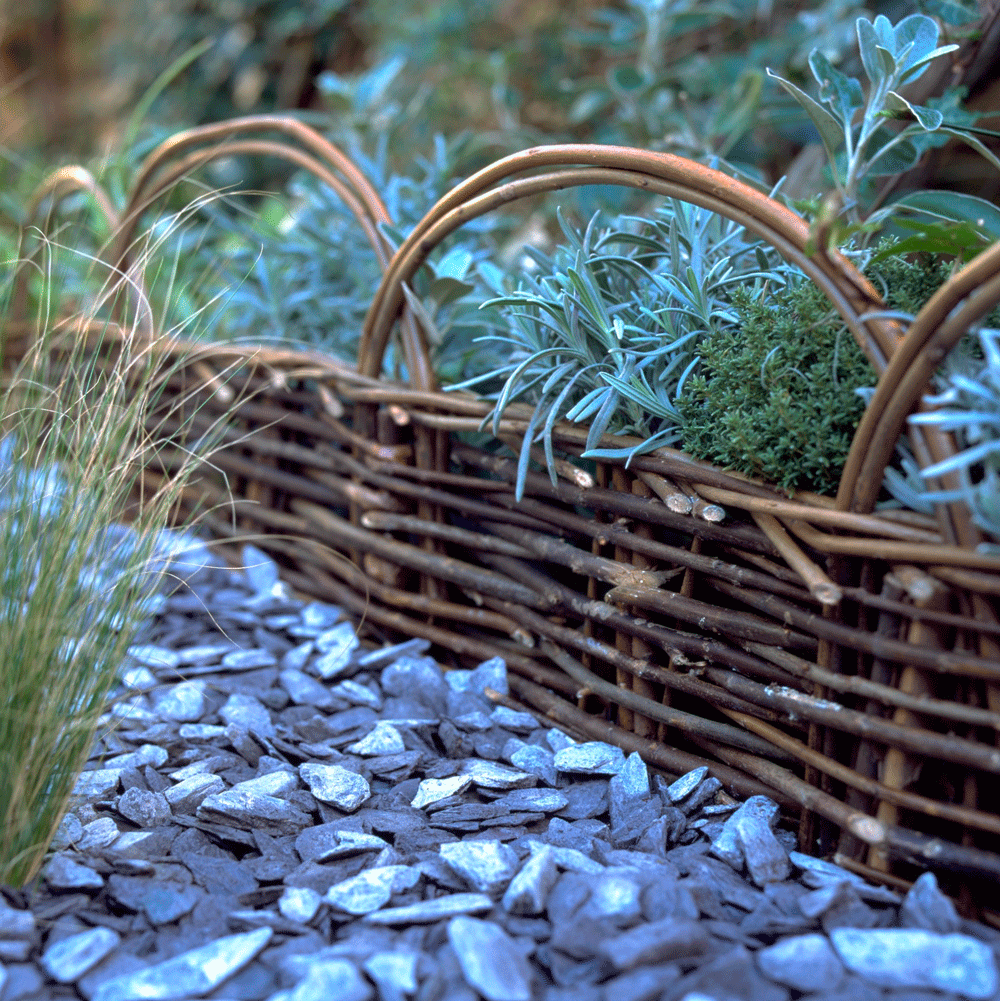
For classic gardens with an English country feel, woven willow, also known as wattle, is perfect for your garden edging ideas.
Wattle is great for creating edging that looks like it has grown with the landscape and has been there for years. If you like getting stuck into your garden, you can create your own wattle edging with willow or hazel because they bend more easily and are less likely to snap.
For the posts, drier twigs and branches, which are sturdy, work best. Wattle edging makes a great wind barrier so it's ideal for edging around vegetable or flower beds which need greater protection from harsh winds.
7. Go rustic with edging hoops
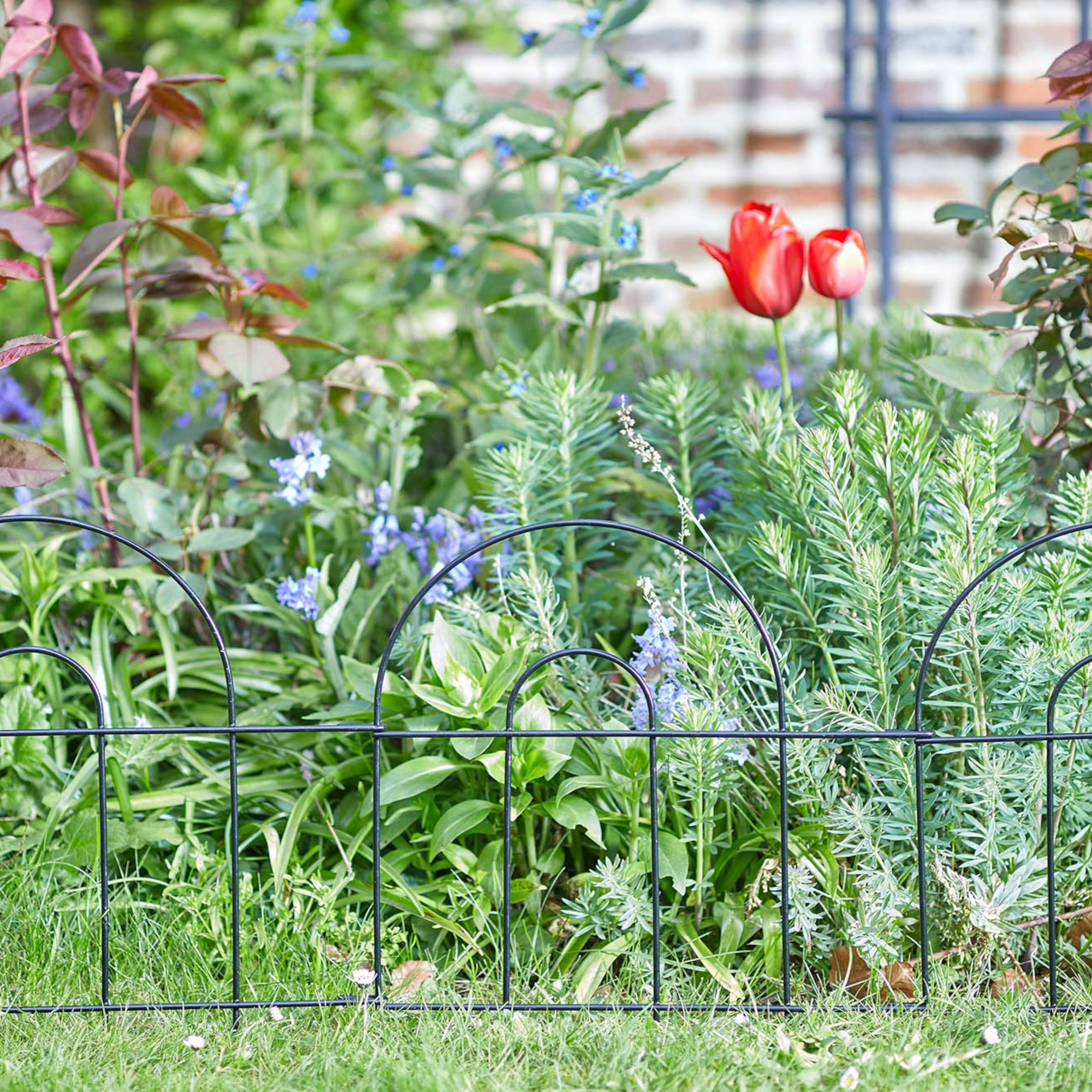
If you don’t need a clean sharp edging line, edging hoops are a lovely way to line a border, especially if it is curved. Edging hoops work best for less formal gardens and keep plants and flowers off of lawns and paths. The hoops are easy to install and are easier to push into softer soil, so wet the ground before installing if necessary.
The hoops often have a decorative design, so make a nice rustic feature against the backdrop of natural grass and plants. 'By slightly overlapping metal hoops, you’ll be able to create simple but effective edging for plants that tend to flop over,' adds gardener Sarah Raven.
8. Incorporate bamboo into your edging
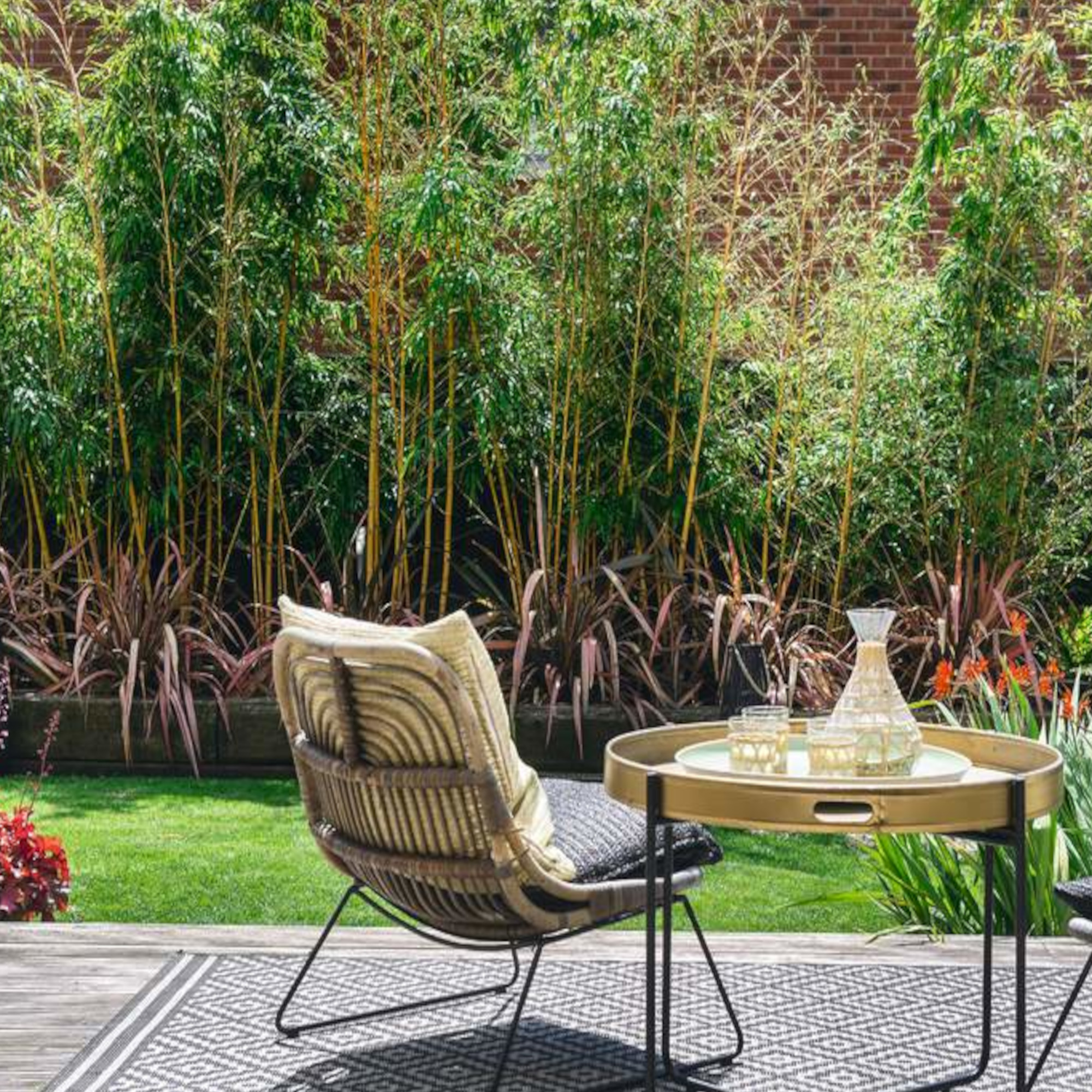
For edging that has a natural style, bamboo is an affordable and easy option to install that will blend in with the rest of your garden and can match your garden fence ideas. You can create your own bamboo edging or buy it ready-made, and because it comes in a variety of colours, you can mix and match to add variety and a textural look to your edging.
‘If you want to save money, you can even make your own bamboo edging from lengths of bamboo and garden wire,’ says Fiona Jenkins, gardening expert at MyJobQuote.
‘If you create your own, you have the benefit of being able to adjust the height to your specific needs so that it suits your garden. You can use bamboo edging in curves or straight lines to achieve your desired look. Bamboo is a great option for all gardens but looks particularly great when surrounding a water feature or in an oriental-style garden.'
9. Spice up your edging with painted rocks
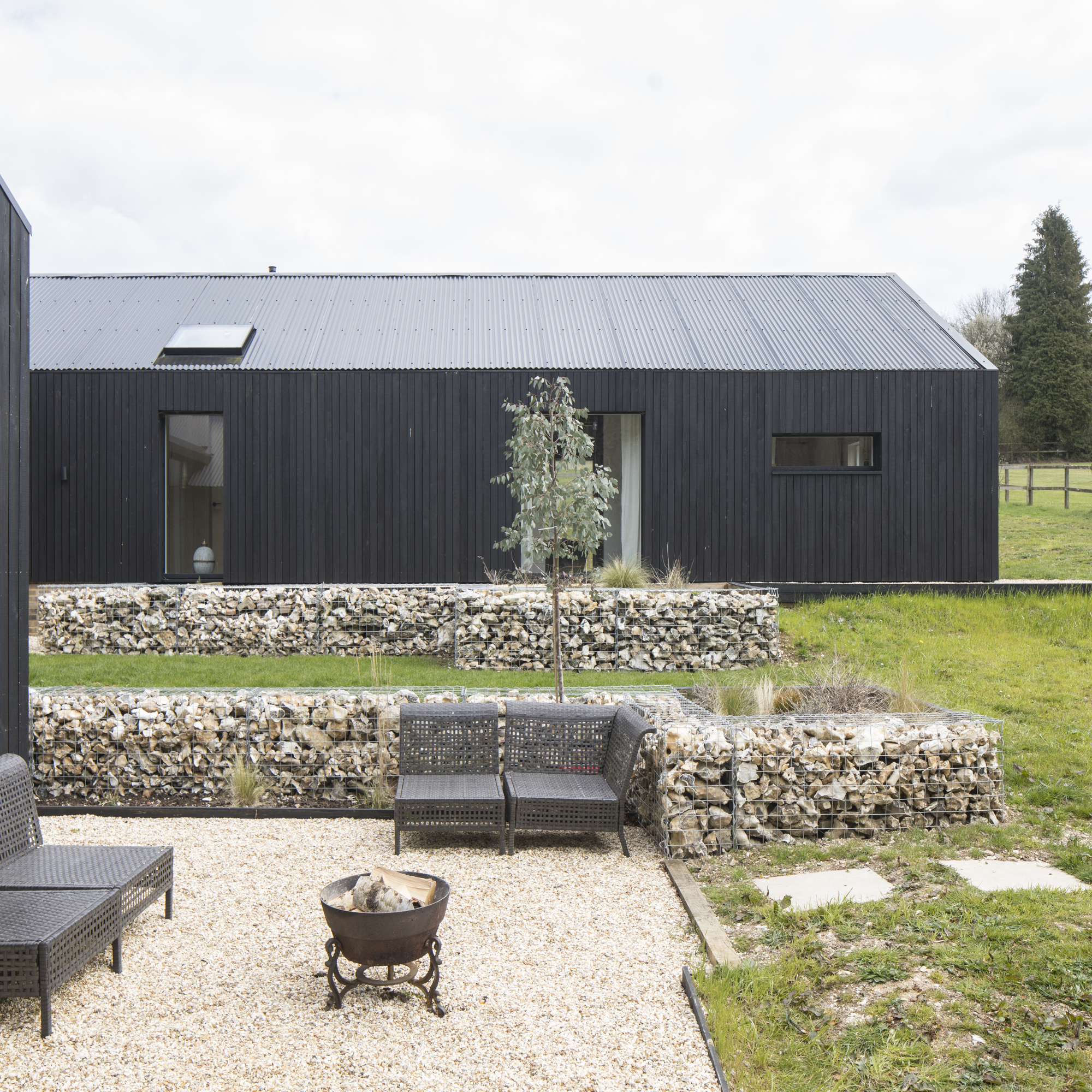
Pol Bishop, horticulturist and gardening expert at Fantastic Gardeners, recommends combining something natural and colourful by using painted rocks, which might be part of your garden paint ideas. If you choose to use rocks for edging, limestone, sandstone, granite or shale would work best and can be bought at a local nursery or landscaping outlet.
‘You can add a pop of colour to a garden bed by arranging painted river rocks in a gradient of colours along the edge,' suggests Pol. 'River rocks and decorative gravel also provide a natural and rustic feel to gardens.'
'To form a border, simply gather rocks, clean and dry them, and then paint them in colours of your choosing. Once the paint is dry, arrange the rocks along the edge of the garden bed and touch up the colours as needed if they begin to fade or the paint chips over time.'
10. Lay down pebbles
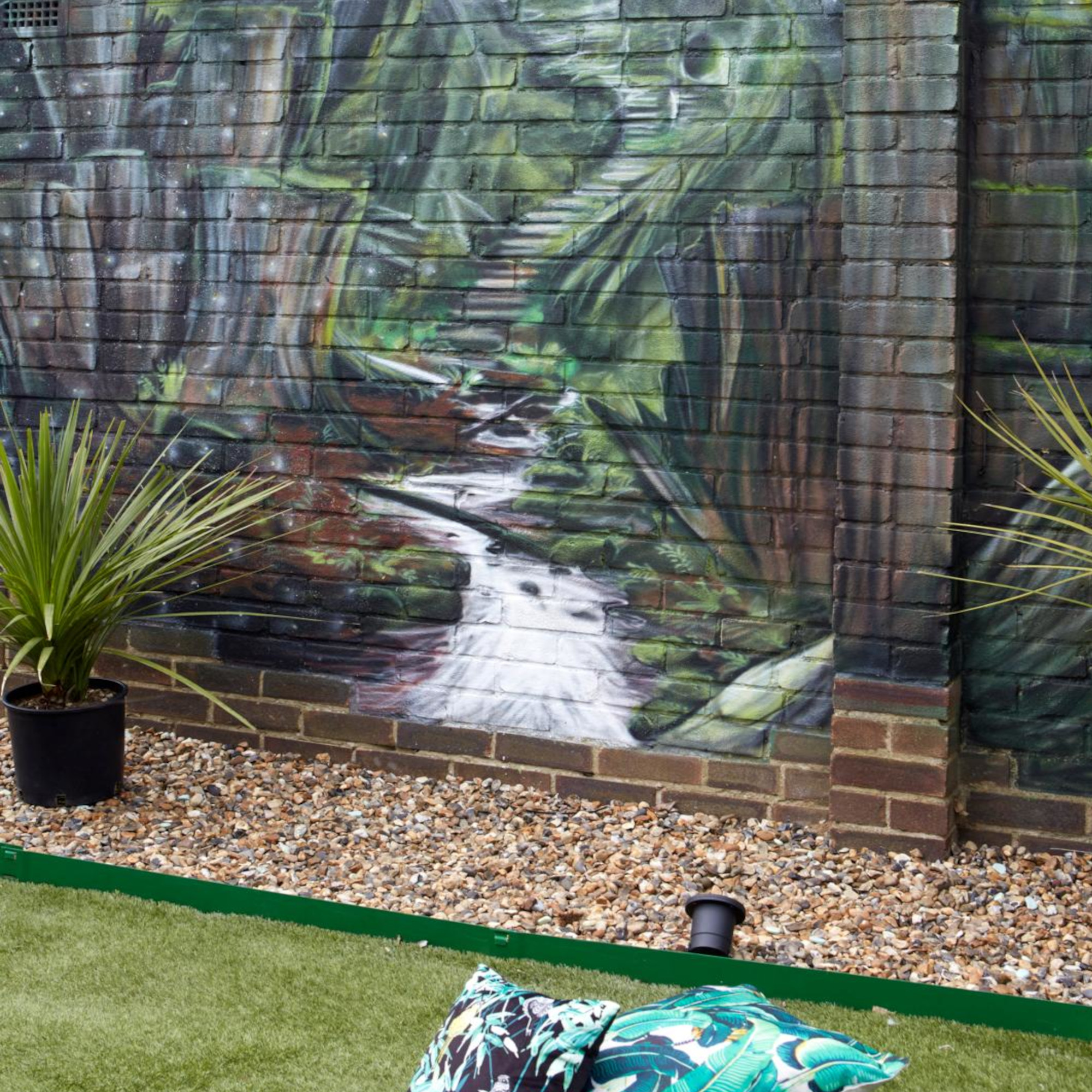
Pebbles are not only for playing with on Brighton Beach but can create beautiful garden edging ideas, too. Pebbles can be stacked to create a raised edge if you want them to be prominent or laid out in a trail for a more subtle design.
‘Small rocks or pebbles are easily found in any gardening store and they are a natural way of creating a garden edge area,' says Jack Sutcliffe, founder of Power Sheds. 'There will be more variety in terms of shapes, sizes and colours so you can pick and choose whichever style suits your garden the most. We recommend placing them in front of a flower bed for a sanctuary-like feel.'
11. Raise your beds

The inclusion of some strategically placed raised beds can work wonders. Not only do they provide a practical way to access cut flowers and vegetables, but they also work as a popular garden edging idea.
The natural definition of the edges neatly separates the beds from lawn or any other garden zone. The material of the raised beds is up to you, but two of the more common choices are stone and wood.
12. Mix up your paving shapes
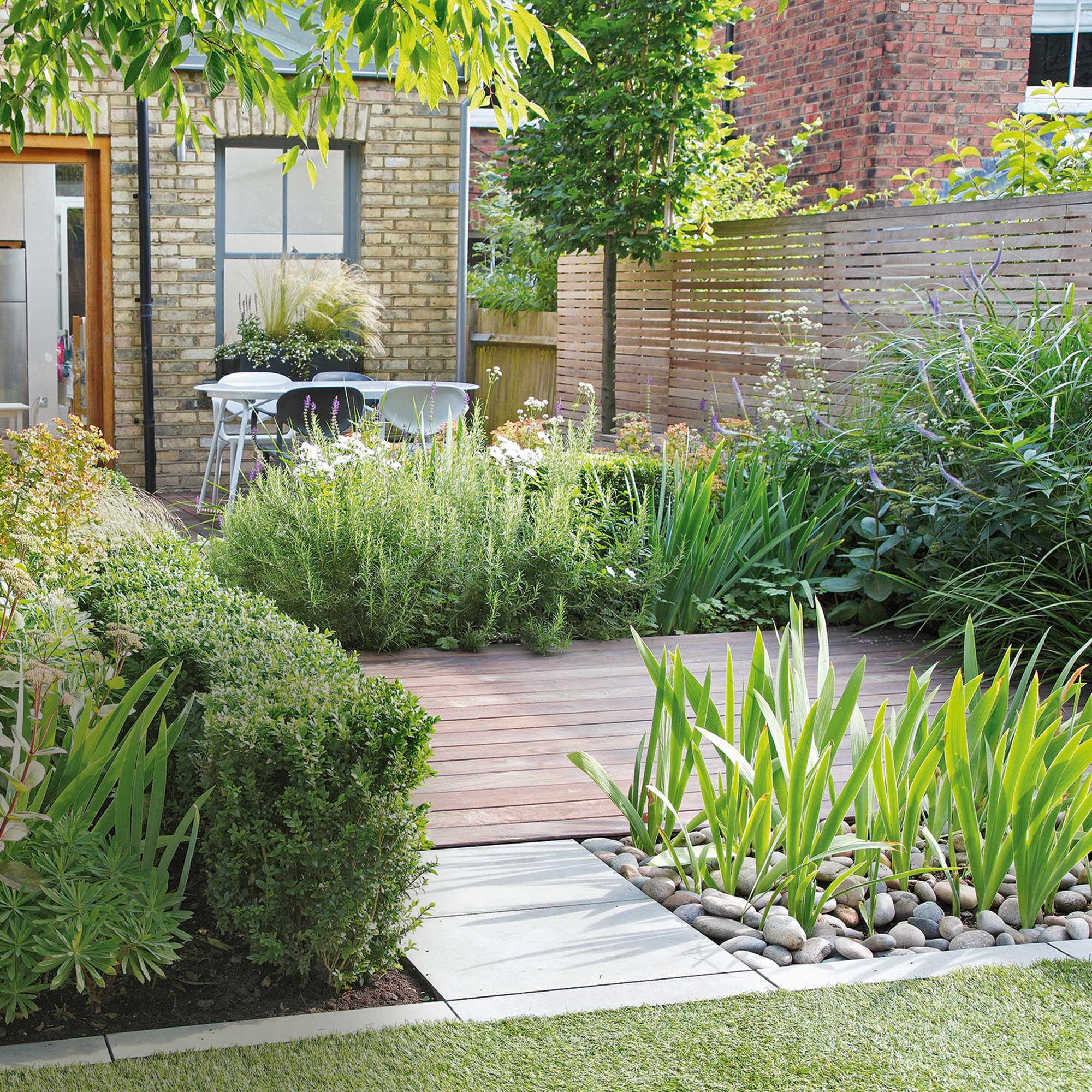
Borders in your garden should be designed to fit, not forced in. If you've found the perfect paving stone, find or cut different widths to make the material neatly sit along where it needs to go. Similarly, for edging inspired by garden decking ideas, you can use varying shapes and sizes of wood.
'Match edging with other paving products for a sleek, minimalist look, or use it on its own to create a focal point,' advises Jen from Bradstone. 'There are plenty of different edging products to choose from, in a variety of styles, stones and colours.'
13. Add a bench
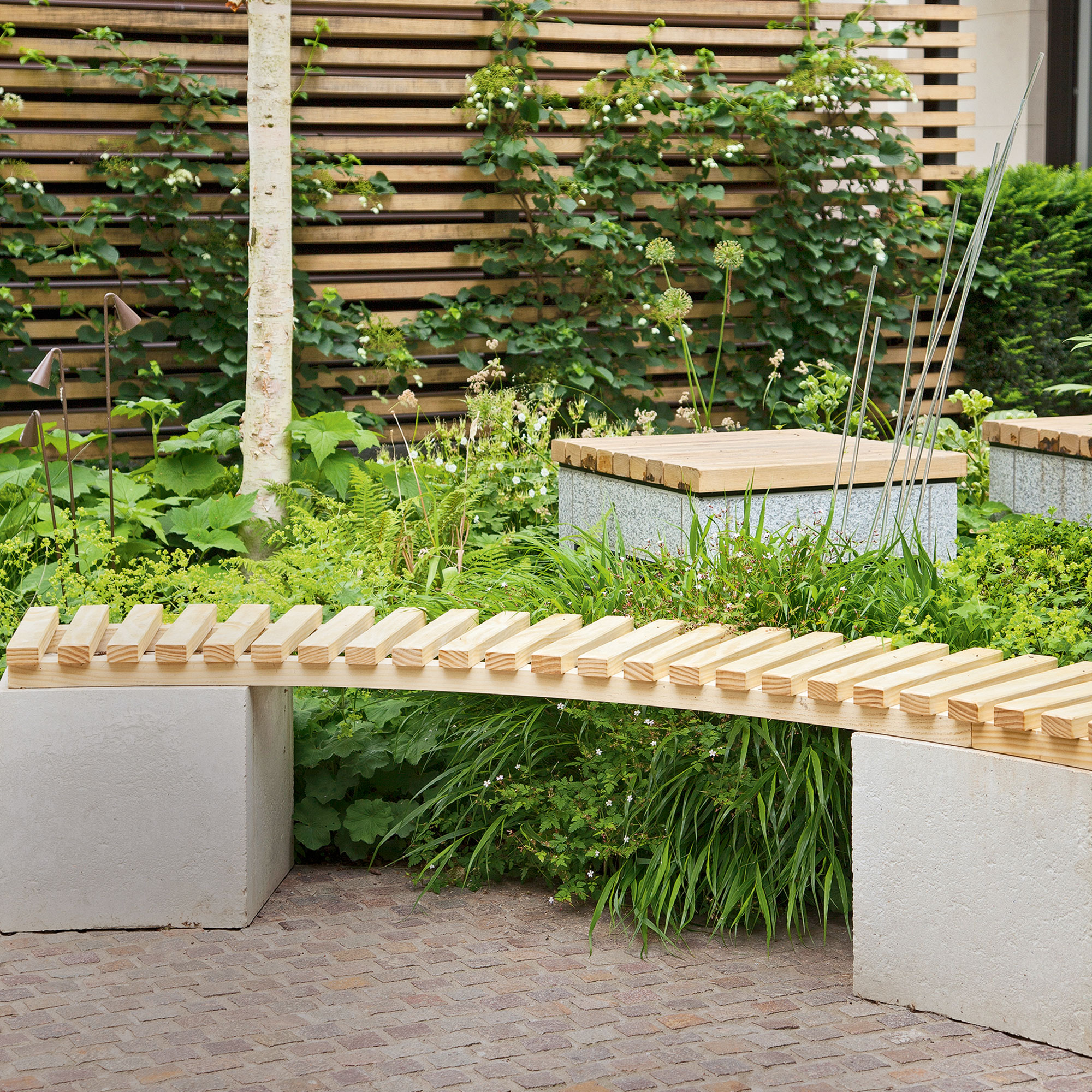
A contemporary alternative to the more traditional garden edging ideas is to create a gentle rather than solid border. One way of achieving this is by using your garden bench ideas to create the same shape as the border of your flower beds.
The seat will give the effect of an edge but still allow the flora to grow a bit wild and naturally underneath. Plus, it doubles up as a place to sit and be surrounded by nature while admiring your garden.
14. Opt for tall planters
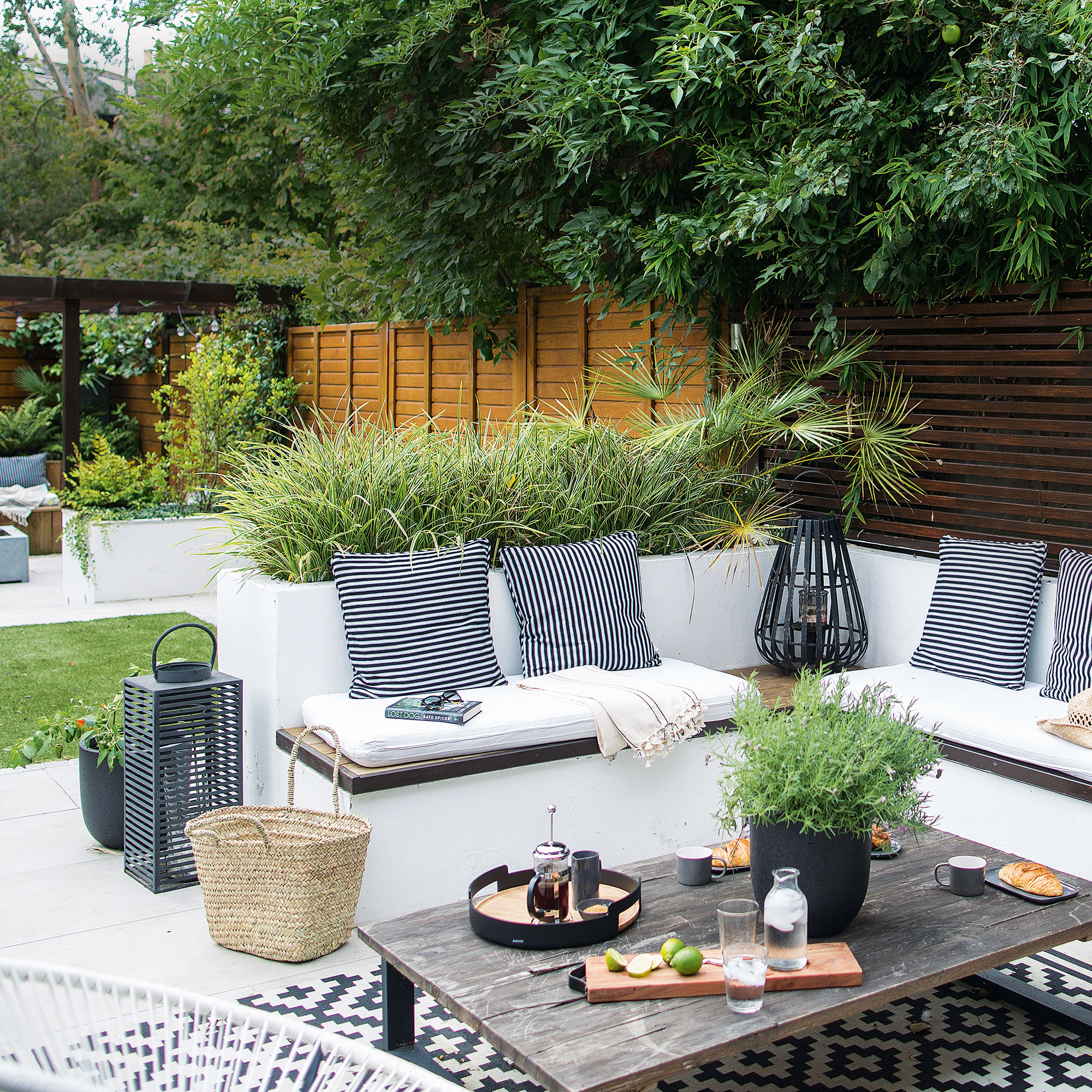
Smaller or city gardens may not have room for raised beds. A more space-friendly option is to include tall planters. These can be freestanding, if you like to move things around, or built-in for a more structural feel. The effect works just as raised beds do but with less of a footprint.
'Flowers are guaranteed to enhance your garden and give more variety both in terms of smell as well as visually,' says Jack from Power Sheds.
15. Lay wood chips
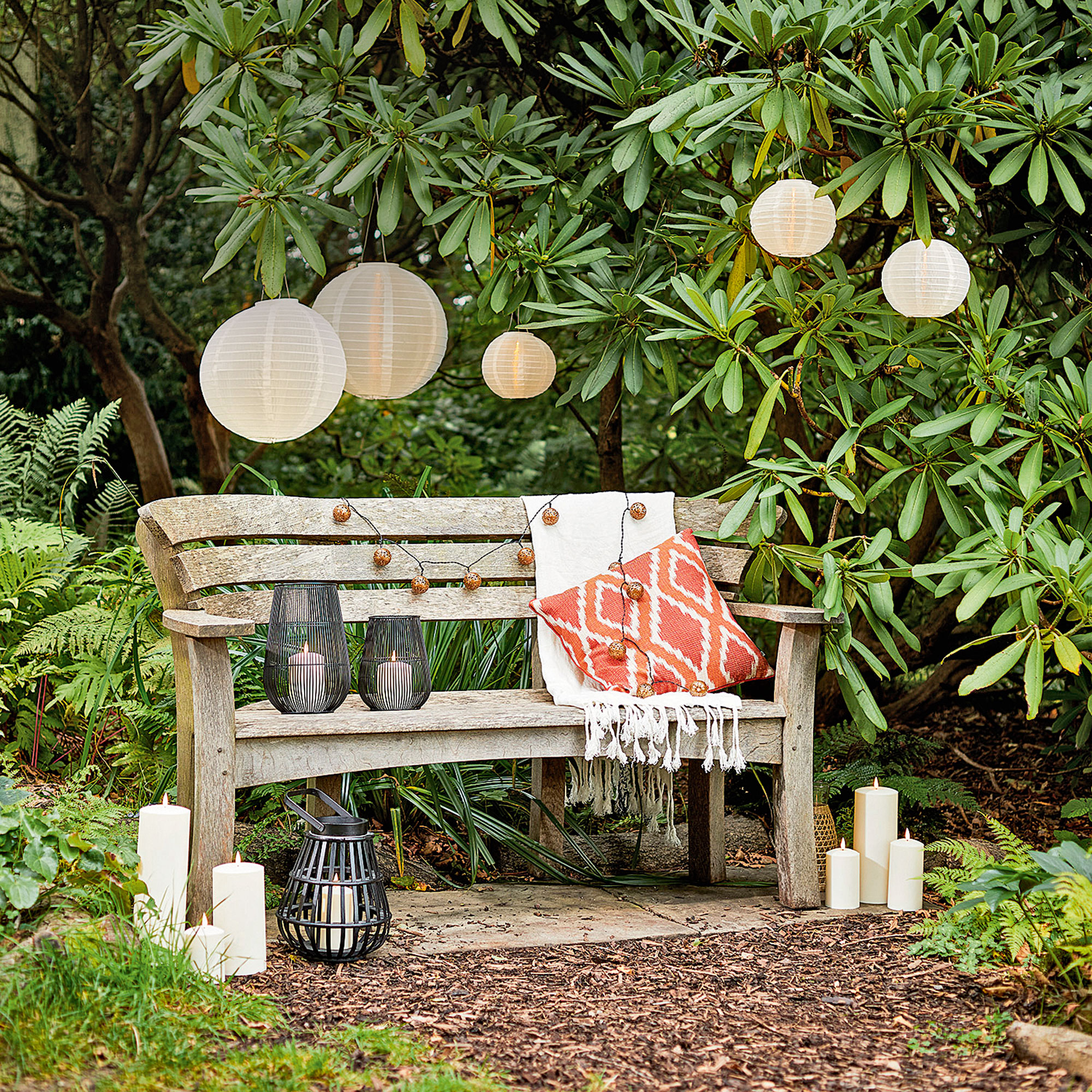
Take inspiration from forests and parks by making use of wood chips to help differentiate your garden zones. It's an easy way to achieve a border and an attractive budget garden idea.
Note that you may have to replenish these if any start to decompose, get blown away in bad weather, or get kicked about by feet. So, this type of edging would work best in areas which aren't overly exposed to the elements.
16. Set a border in contemporary stone
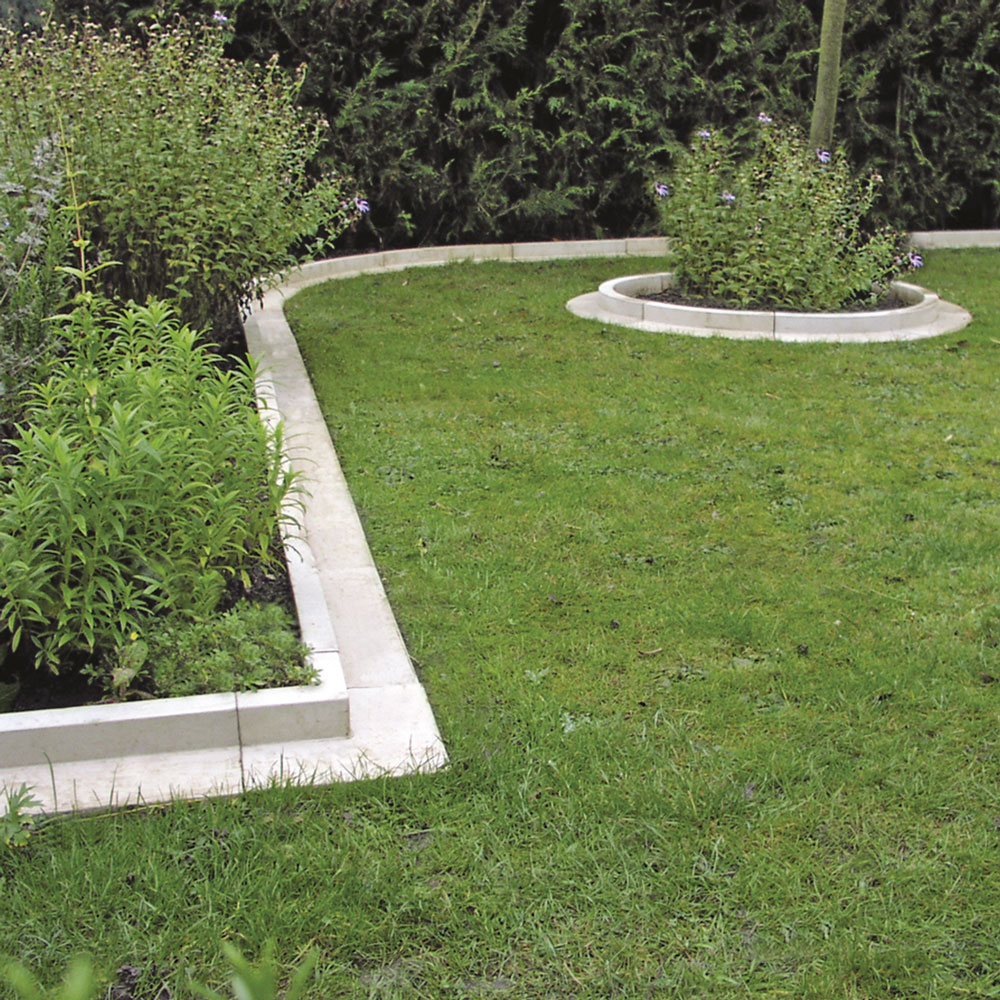
While edging is one of the most practical buys for your garden, it can also be one of the most captivating. A solid edging in contemporary stone is an ideal way to enhance the overall appearance of your garden, giving it clear definition to construct a modern layout.
'Gardeners have plenty of choices when it comes to the creative use of stone,' notes says Anna Hampshire, head of marketing at Marshalls. 'It may be that you favour a sawn stone look in creamy or silvery tones to blend with your planting, or you prefer to create a contrast with it. Quality natural stone lends a garden real warmth, as well as a natural finish.'
17. Keep it simple for a low-budget solution
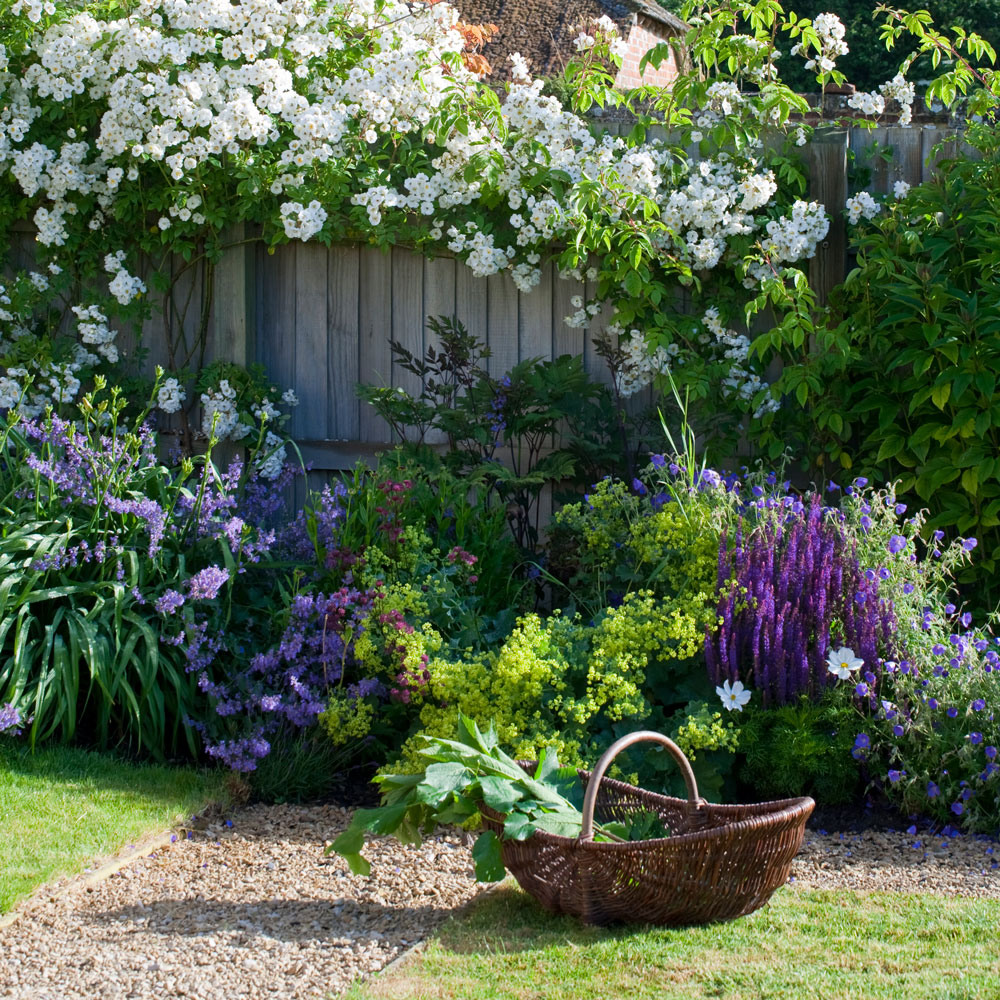
Gravel is the hero buy for many a budget garden. Choose a purse-friendly, practical lawn edged with gravel and edging strip. Adding gravel to a garden landscape lightens the texture. On a practical note, it allows for better drainage and aeration, making it the ideal border as part of your healthy lawn tips.
'Fine gravel is best for smaller gardens and works well around sheds, statues, ponds, and even patios. Larger stones work well around wide or long flower beds. You can get creative with gravel by choosing various colours, sizes, and patterns,' says Fiona from MyJobQuote.
18. Block your garden with slate tiles
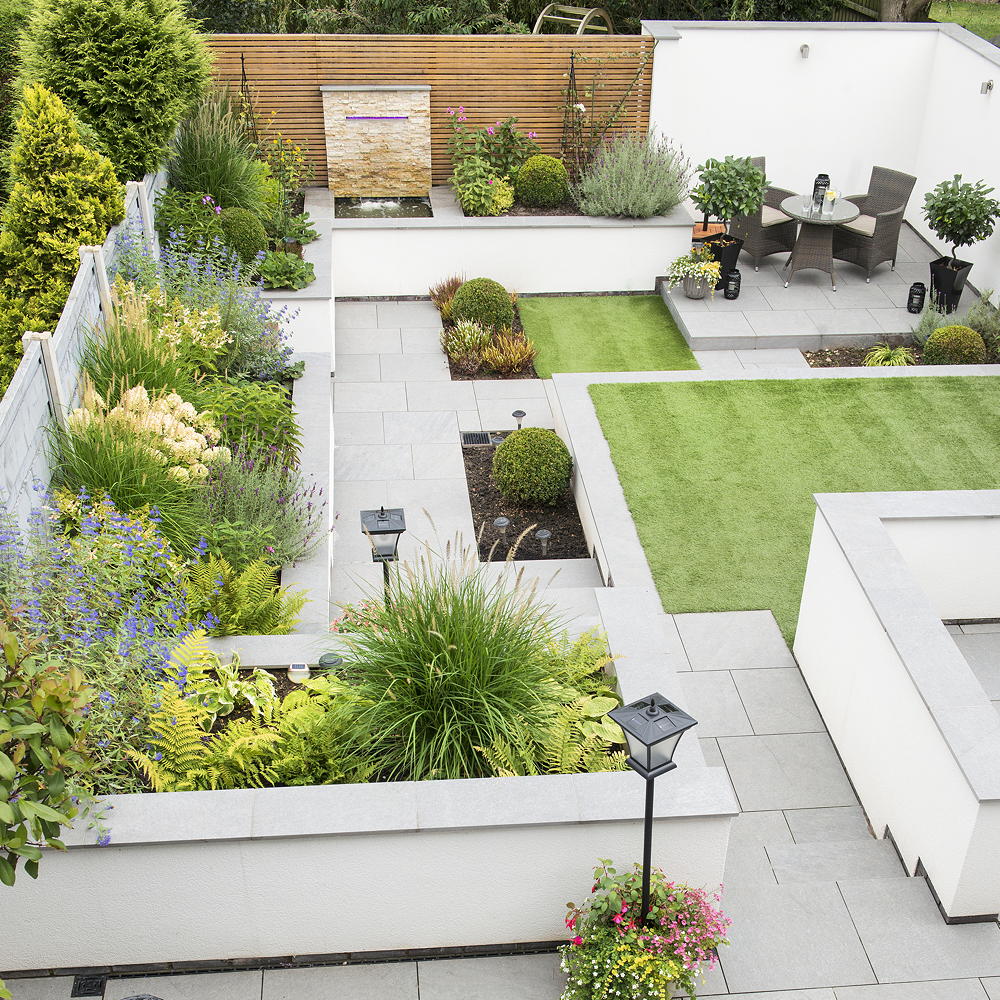
Matching the edging on raised flower beds to the patio is a great way to blend a multi-layered garden together. Grey slate tiles look chic and modern, and they're perfect for complimenting a Mediterranean-style garden bursting with green plants.
19. Lay down railway sleepers
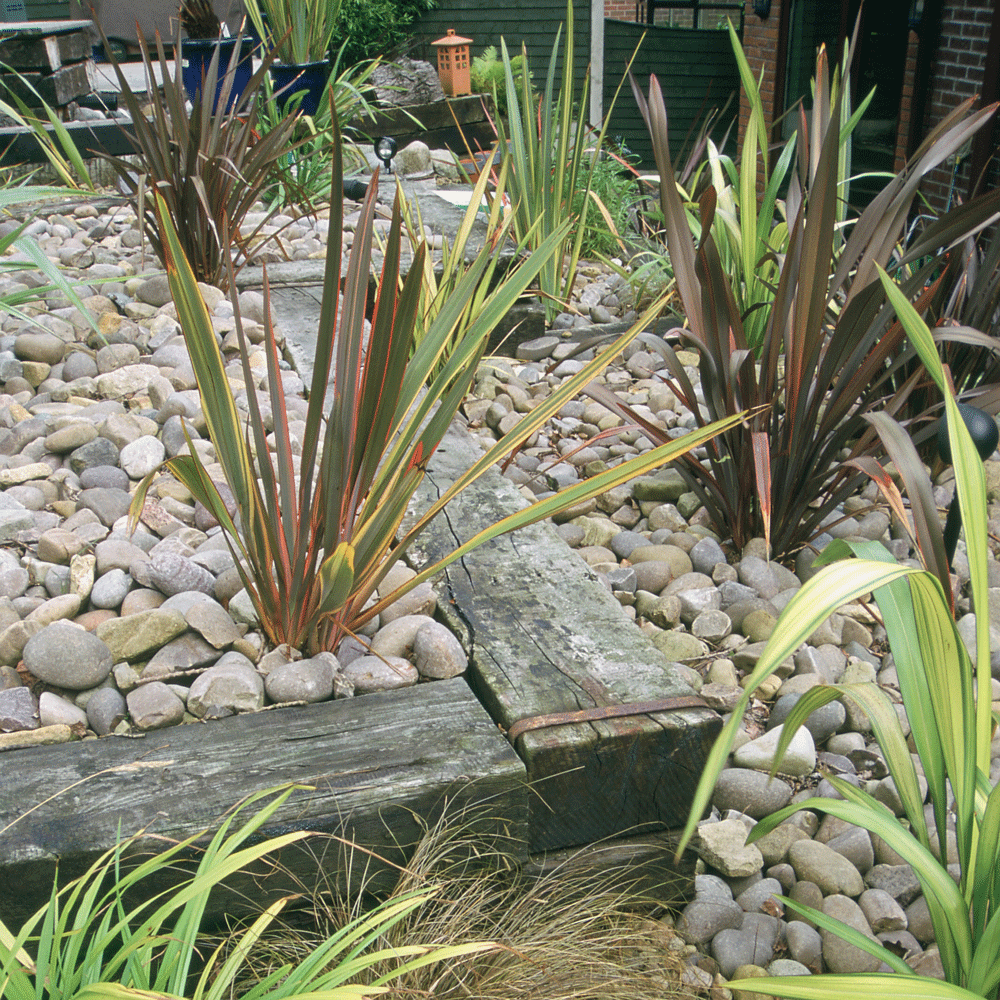
After an industrial look? Upcycled railway sleepers have become a very popular choice for constructing raised flower beds, and there are countless garden railway sleeper ideas to choose from.
Reuse old railway sleepers laid at single height, cut down or even double stacked to give a defined edge to pebbled or grassy areas.
They make a great edging choice for raised vegetable beds, too, as they're perfect for drainage and provide a strong barrier against pests such as slugs and snails. A top tip from us: it's worth investing in certified, high-quality timber that's been treated to ensure it stays in good shape for as long as possible.
20. Be bold with boulders
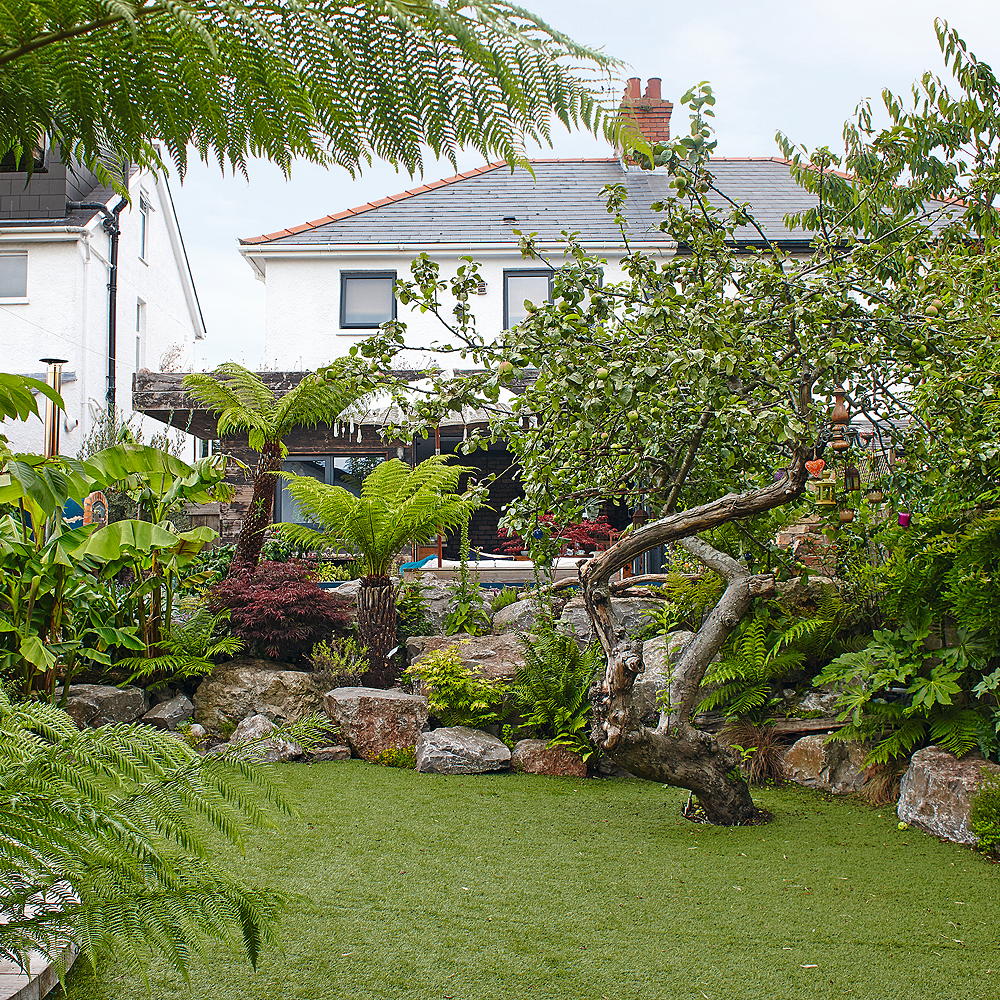
For a more natural-looking garden, consider edging the lawn in stunning large stones or rocks. These are perfect for creating a striking but low-maintenance garden. For an extra splash of colour, consider piling a few of the rocks up and planting some alpine perennials that will cascade over them in spring and summer.
'The rocks themselves can become a feature of their own as well as complimenting wider flowerbeds,' says MyJobQuote's Fiona. 'Since larger rocks tend to be quite heavy, there is no need for cement to ground them. The weight of them will result in them naturally settling, removing the need for any further materials when creating a large rock edge.'
21. Edge with hedges
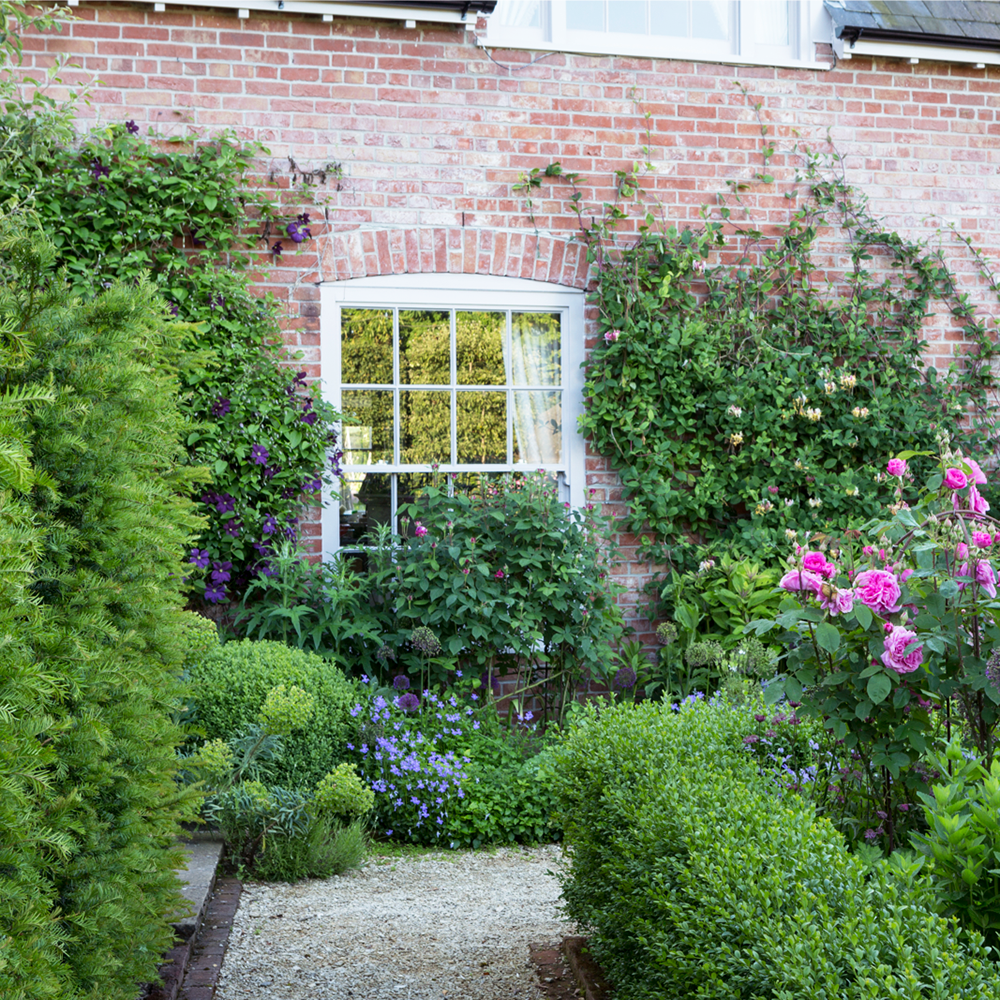
To create a free-form feel for your garden, opt for a natural edging. Allow the planted borders to act as a clearly defined edge without having to put materials in place. Use this free design for a classic method garden feel.
22. Dare to be different with a sculptural design
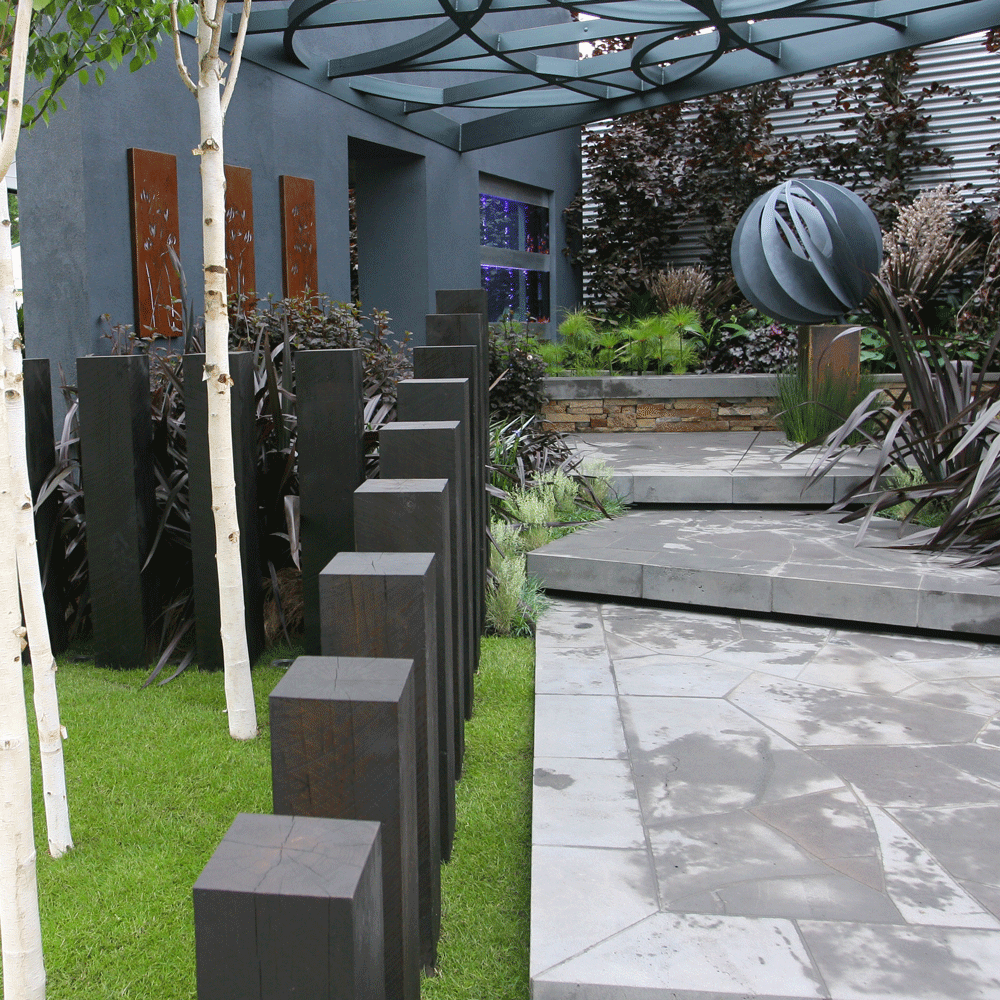
A playful take on a garden fence idea, this sculptural design creates a clear divide between the soft turf and the modern patio paving without creating a solid barrier, which could disrupt the flow of the open space.
These hearty blackened wooden plinths add serious style power to an ultra-modern garden design.
FAQs
What is the easiest garden edging to install?
'The easiest garden edging to install is edging that doesn't require digging,' says Lee Trethewey from Sustainable Furniture. 'Instead, you have to hammer the edging into the ground, and it's usually a much quicker and easier process.
'No dig garden edging will likely come in rolls or strips, and in either plastic or metal. It's usually easier to make curved shapes out of than other methods of edging.'
What can I use for garden edging?
Your garden edging ideas need to reflect the existing style of your garden, so consider what would work with your planting themes, colour choices, garden furniture and general ambience. Off-cut logs and rustic willow are nice edging options for traditional country gardens. Or try combining concrete slabs and railway sleepers for a cool, industrial feel.
When it comes to garden edging ideas, there are many different materials available to use for edging and defining your garden spaces. When thinking about how to plan a garden, edging should factor in so you can choose the right option which will suit your overall garden scheme. You can use materials from plastic, metal, timber, and natural rock to experiment with what works best for your garden.
‘Experimenting with edging is a great way for people to get started with sprucing up their gardens,’ says Suhail Patel founder of Luxury Screens. ‘Why not try using plants of different heights and textures, mix and match materials like rock wood or metal or perhaps add lighting elements to highlight specific areas at night.
'Another way to define the boundaries of your outdoor area could be to try a decorative screen which can also add some privacy. Don’t forget to get creative by incorporating scalloped, zig-zag, or wave patterns as well as curved lines instead of straight ones.’
With so many garden edging ideas to choose from, which will you be experimenting with?







